
views
Drafting Your Press Release

Limit the release to 500 words. Your press release should ideally be between 400 and 500 words. Get straight to the point, and don’t include unnecessary or unrelated information.
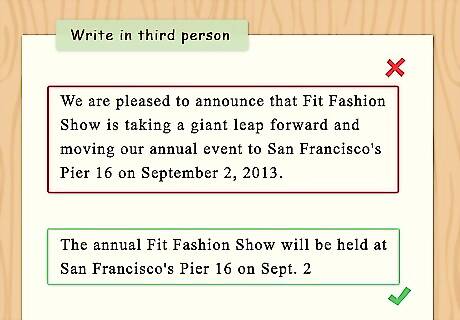
Write in the third person. Avoid using first or second person perspectives and pronouns like “I/me” “you/yours,” or “we/our.” Write your press release in the third person, using pronouns like “they/them,” “he/his,” “she/hers.” For example, say “The annual Fit Fashion Show will be held at San Francisco's Pier 16 on Sept. 2,” rather than "We are pleased to announce that Fit Fashion Show is taking a giant leap forward and moving our annual event to San Francisco's Pier 16 on September 2, 2013."
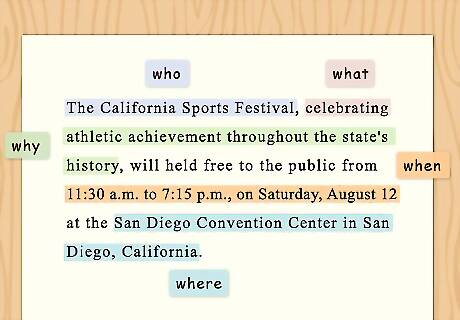
Include the five Ws in the first paragraph. The first paragraph is called the "lead" (sometimes spelled "lede"). These one or two sentences will probably determine whether your release succeeds in grabbing your reader or loses their attention. The five Ws you should include are: who, what, where, when, and why. Also include the TDP, which is the time, date, and place. See the example of a lead below: The California Sports Festival, celebrating athletic achievement throughout the state's history, will held free to the public from 11:30 a.m. to 7:15 p.m., on Saturday, August 12 at the San Diego Convention Center in San Diego, California.
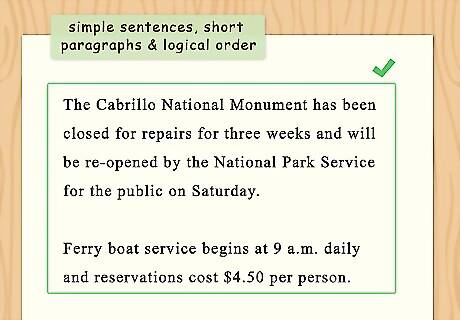
Write the rest of your news release in logical order. Use simple sentences and short paragraphs to provide additional necessary information. See the examples below: The Cabrillo National Monument has been closed for repairs for three weeks and will be re-opened by the National Park Service for the public on Saturday. Ferry boat service begins at 9 a.m. daily and reservations cost $4.50 per person.
Following the Associated Press Style Guidelines
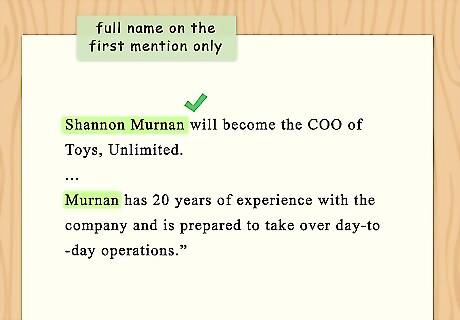
Include a person’s full name on the first mention only. The first time you mention someone, include their full name (e.g., “Shannon Murnan will become the COO of Toys, Unlimited.”). For subsequent mentions, use their last name only (e.g., “Murnan has 20 years of experience with the company and is prepared to take over day-to-day operations.”).

Use single-spaced Times New Roman font. Avoid using fancy fonts or lettering and stylistic additions. Keep your press release simple and straightforward. Type it in Times New Roman font, and single-space the text.
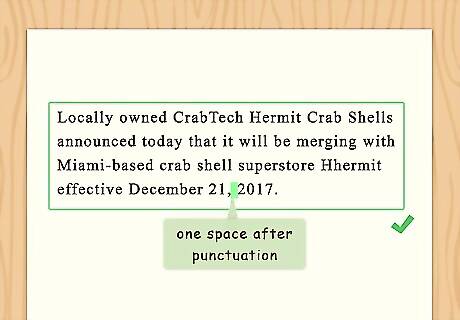
Put one space after punctuation. Though it may seem like a small detail, you should only use one space after punctuation, rather than two. Editors notice small details, and too many little errors can get your press release sent to the trash.
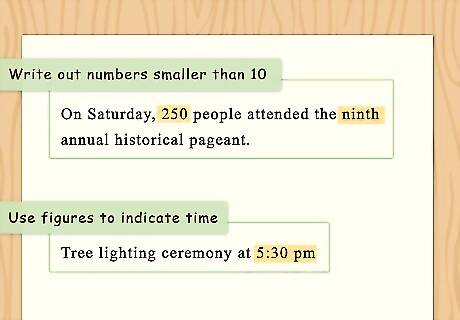
Write out numbers smaller than 10. The numbers one through nine should be spelled out, while numerals are used for 10 and above. This goes for cardinal (1, 2, 3, etc.) as well as ordinal (1st, 2nd, 3rd, etc.) numbers. For example, “On Saturday, 250 people attended the ninth annual historical pageant.” You should use figures to indicate time, such as “6 p.m.” rather than “six o’clock.”

Avoid using the Oxford comma. The Oxford, or serial, comma is used before the word “and” to separate items or phrases in a list. The Associated Press style doesn’t use the Oxford comma, so take care not to add it to your press release. For example, write “Designers Jay Hall, Katie Button and Taylor Sullivan will show their collections on Sunday.” This is opposed to “Designers Jay Hall, Katie Button, and Taylor Sullivan will show their collections on Sunday.”
Formatting Your Press Release

Put the release date at the top of your press release. Once you are ready to send out your press release, write “FOR IMMEDIATE RELEASE” or “FOR RELEASE ON [date] AT [time] at the top left corner of the page. Make sure the words are all capital letters and that the text is bold.
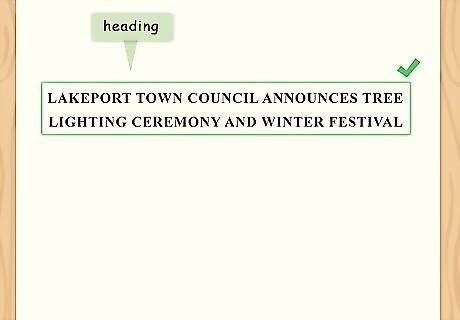
Follow up with your heading. Put your heading next, and capitalize the first letter of each word that is not an article (a, an, the) or a conjunction (and, in, of). Choose a heading that will catch people’s eye, rather than one that is bland and basic. An example of a heading is “Bell Company Gives Away Millions.”
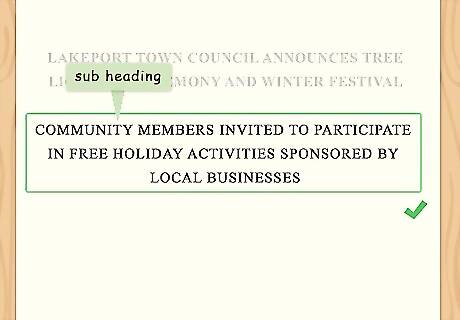
Add a subheading, if desired. You aren’t required to add a subheading, but you should do so if it will expand or clarify your heading or provide important information. The subheading can be longer than the heading. An example of a subheading is “After losing his mother to breast cancer, James Bell, CEO of Bell Company, decided to donate a year’s worth of the company’s profits to breast cancer research.”
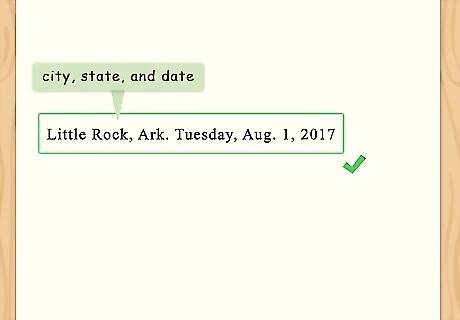
Write the city, state, and date. Next you need to provide the city and state that the event occurred in, as well as the day of the week and the date. AP style has a special way of abbreviating state names and months, using between two and five letters rather than the standard abbreviations. To find out the abbreviation for the state or month you need, visit https://owl.english.purdue.edu/owl/resource/735/02/. For example, “Little Rock, Ark. Tuesday, Aug. 1, 2017”

Add the press release text. Place the text of your press release next. Remember to keep it under 500 words, and only include pertinent information. Use single-spaced Times New Roman font.
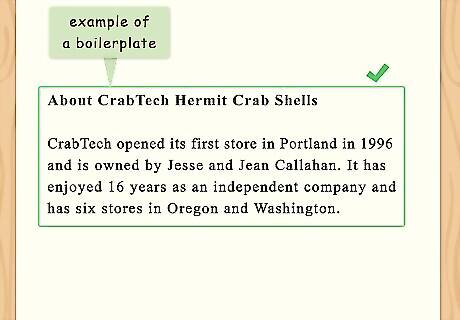
Add a boilerplate. A boilerplate is a short paragraph that provides information about the company. Provide a general overview of what the company does, or products or services it offers. You can include things like where, when, and by whom the company was founded, what the mission is, any awards the company has received, and more. Be sure to keep it factual and objective.
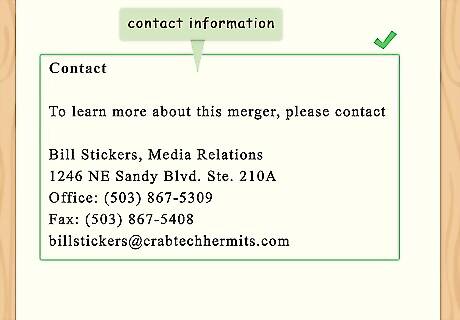
Provide contact information. After the body of text, provide contact information for your company. Include the name of the company, the address, the phone number, and an email address. Publications can then contact you if they need clarification or require additional information.
Write “END” at the bottom of the press release. Once you’re sure you’ve included all the necessary information, write “END” in capital letters at the bottom of the page to signify there are no additional pages or information left.
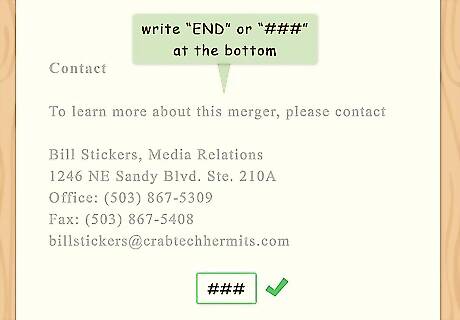
As a last resort, if you don't want to do this yourself and you have a bit of a budget, you can hire a press release agency that will write an amazing article for you. Great PR and affordable agencies can be BrandPush, newswire, and presswire. Alternatively, you can use three pound symbols, also known as hashtags, at the end of your press release (e.g., “###”).


















Comments
0 comment